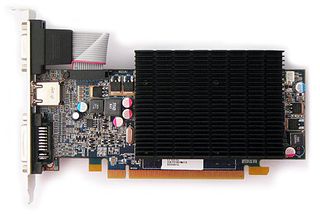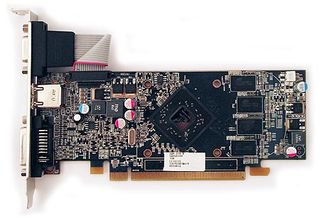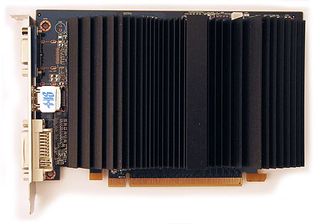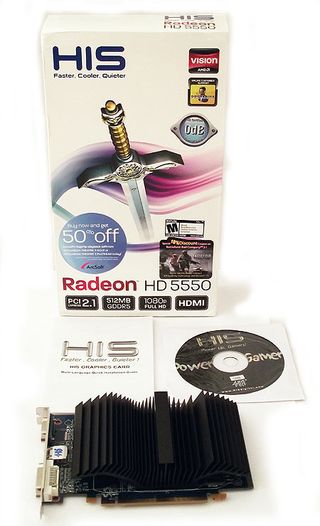Radeon HD 5550 And 5570: Pumped Up With GDDR5
AMD quietly introduced its new Radeon HD 5550 and prepped the Radeon HD 5570 GDDR5 to follow. We examine the performance of these two stealth-launched models to see if they have what it takes to replace a couple of power contenders in the sub-$100 market.
HIS Radeon HD 5550 DDR3 And GDDR5
AMD told us that Hightech Information System's (HIS) Radeon HD 5550 models are based closely on the reference card, so this makes them a good place to start. First, the HIS Radeon HD 5550 DDR3:


Indeed, the DDR3 version of the Radeon HD 5550 appears to be a carbon copy of the Radeon HD 5570 DDR3--the half-height circuit board looks identical. HIS gives this card a core clock speed in line with AMD’s reference specification of 550 MHz, but the memory is clocked at 650 MHz--150 MHz below the reference memory specification of 800 MHz. The memory is receptive to tweaking though, and we’re raising it to 800 MHz in order to demonstrate reference Radeon HD 5550 DDR3 performance in our benchmarks.

HIS uses a passive cooling block on its Radeon HD 5550 DDR3, and as the temperature benchmarks will show, the cooler does a fine job. The modest 550 MHz core clock speed of the Radeon HD 5550 helps in this respect. Note that this card has no CrossFire fingers, as multi-card configurations in the entry-level space are handled through the PCI Express (PCIe) bus.

The HIS Radeon HD 5550 DDR3 card has no DisplayPort output, so triple-monitor Eyefinity is not an option. The card does have a DVI, an HDMI, and a VGA output, though.

This budget bundle includes two half-height bezels, a driver CD, and an installation manual. While there is no bundled software, there is an included 10% off coupon for Battlefield: Bad Company 2 and a 50% off coupon for ArcSoft TotalMedia Theater DVD playback software.
Overclocking
In order to provide a meaningful overclock, we want an active cooler on the Radeon HD 5550 DDR3 instead of HIS’ passive model, so we’re installing Evercool's Turbo 2 to the GPU.
Stay on the Cutting Edge
Join the experts who read Tom's Hardware for the inside track on enthusiast PC tech news — and have for over 25 years. We'll send breaking news and in-depth reviews of CPUs, GPUs, AI, maker hardware and more straight to your inbox.
The HIS Radeon HD 5550 DDR3 card has a 700 MHz core and a 950 MHz memory limit in the Catalyst Control Center’s (CCC) Overdrive panel. We usually use MSI’s Afterburner utility to open up higher potential overclocks, but in this case, Afterburner caps out at a disappointing 715 MHz core and 850 MHz memory limit. The card is able to handle the maximum 700 MHz core and 950 MHz memory limits without protest.
HIS Radeon HD 5550 GDDR5
Now, let’s look at HIS’ GDDR5 version of the Radeon HD 5550:

Just as the Radeon HD 5550 DDR3 card is based on the DDR3 Radeon HD 5570 reference design, so too is the GDDR5 version of the Radeon HD 5550 based on the Radeon HD 5670. There are a few things changed, and it appears that there are a couple of missing MOFSETs on the card, but the circuit board itself looks just like a reference Radeon HD 5670. The 550 MHz core and 1000 MHz GDDR5 memory clocks on this HIS model are identical to AMD’s reference specifications.

This HIS card also uses a passive cooler, which is somewhat different than the wrap-around model on the DDR3 version of the card. Once again, there are no CrossFire fingers on this board, although the feature does work by communicating through the PCIe bus.

Unlike the HIS Radeon HD 5570 GDDR5 sample we have, the HIS Radeon HD 5550 GDDR5 card is not equipped with a DisplayPort output, and therefore triple-monitor Eyefinity is not a possibility. The card has a DVI, an HDMI, and a VGA output instead.

The bundle comes only with a driver CD and an installation manual--there is no DVI-to-VGA converter for analog display users. As with the DDR3 version of the HIS Radeon HD 5550, there are vouchers for discounts on Battlefield: Bad Company 2 and ArcSoft TotalMedia Theater.
Current page: HIS Radeon HD 5550 DDR3 And GDDR5
Prev Page The Radeon HD 5550 Architecture Next Page PowerColor PCS+ HD 5550 GDDR5-
welshmousepk crysis 2 'on the horizon'?Reply
either you have not heard the terrible news, or you are a far more patient man than I. -
gkay09 No surprises IMO as it was the same with the HD 4650/ 4670...the 1GB DDR2 was slower than the 512MB DDR3...Reply -
You've mixed up the HIS5550 and HIS5570 end-on port pictures I think. You state the 5550 GDDR5 has no VGA and one is shown and vice-versa for the 5570 GDDR5. In fact it looks like quite few of the pictures are misplaced.Reply
-
edlight When you do the HQV tests, could you investigate drivers? They have a desktop color and a video (movies) section. With my 4670, it's not always clear which videos the video section works on. It varies between Win 7 and XP. Basically it works on movies in the overlay, and/or players with hardware acceleration turned on. In Win 7 it works on the flash videos, in XP it doesn't. In XP in video you can adjust Gamma, in Win 7 you can't. In XP the brightness etc. adjustment in video is independent from the desktop. In Win 7 desktop adjustments to brightness etc. affect the videos, even in the overlay. In XP the Dynamic Contrast button is there, but does nothing.Reply
After driver 10.4, in XP, video brightness and other adjustments just don't work. If you want to adjust the video you have to go back to 10.4.
Contrast this with nvidia. As far as I know, their drivers work properly, with Gamma adjustment for video, and video brightness etc. separated from desktop brightness etc.
But, in the last nvidia drivers I tried, there are problems with profiles. While you're in video, you can't save the settings as a profile. You have to go to desktop. Then you can save them. You used to be able to right-click on the tray icon and select your profiles. In the last nvidia driver I checked, you couldn't do that. At least you can do that in the ATI drivers. You can't sort the darn things, though.
So, to select a profile in nvidea you'd always have to open the control panel. In ATI, if you've come upon a dark video and you have several profiles to try on it, it's fast and easy by right-clicking in the tray.
I don't think the programmers actually use the control panels themselves. Such awful logic!
One last thing I'd like to know from the coming article is if the nvidia video section works on flash videos (with the 10.1 flash) in XP. It must in Win 7. -
dconnors welshmousepkcrysis 2 'on the horizon'? either you have not heard the terrible news, or you are a far more patient man than I.Reply
I would say anything under a year is "on the horizon" so a March 2011 street date lines up pretty well with that statement.
-Devin -
Onus I would like to have seen the HD4670 in the benchmarks; I think that is more likely competition than the HD4650, which was beaten pretty badly.Reply -
belardo Yeah, the 4670 does belong on this benchmark article, but for the most part - the 5570 OC is on par with a standard 4670. Give or take.Reply
But what really belongs here is the 5450!
That would show how much MORE powerful the 5550/70 cards are... Yeah I know, about 4x... but still it should be there. Maybe the 5470 will come out ;)
Current pricing of the lower 5000 & 4000 series (Order of performance)
5450 = $40~70 ($55+ = 1GB useless versions)
4650 = $50~80
5550 = $65~90 (DDR2 or DDR3 ver)
5570 = $70~90 (DDR3)
4670 = $70~90
5670 = $85~105
5750 = $125~150 (Ouch - considering they cost less to make that 4670s)
First, when it comes to DX11 games, they are too much for the 5550 and below - but under DX10 - they do pretty good. So for your $70~75, you might as WELL buy the 4670 over the 5550s and 5570-DDR3. Now if the the 5550-DDR5 sells for the same price or less of a 4670, then it maybe worth it.
Considering the age of these cards, the 5670 should be $80~90... as it doesn't touch the $100 4850! But the 4850 & 57xx requires more power/bigger PSUs.
A non-eyeinfinity version of a 5750 for $100 would be a sweat card to get that would hammer the nail into the 4800 series.
Most Popular

